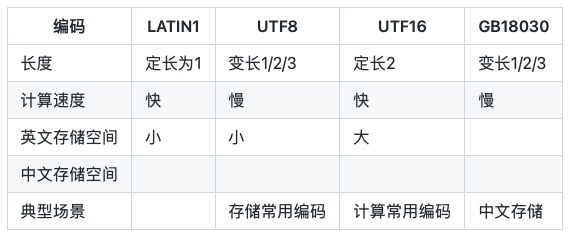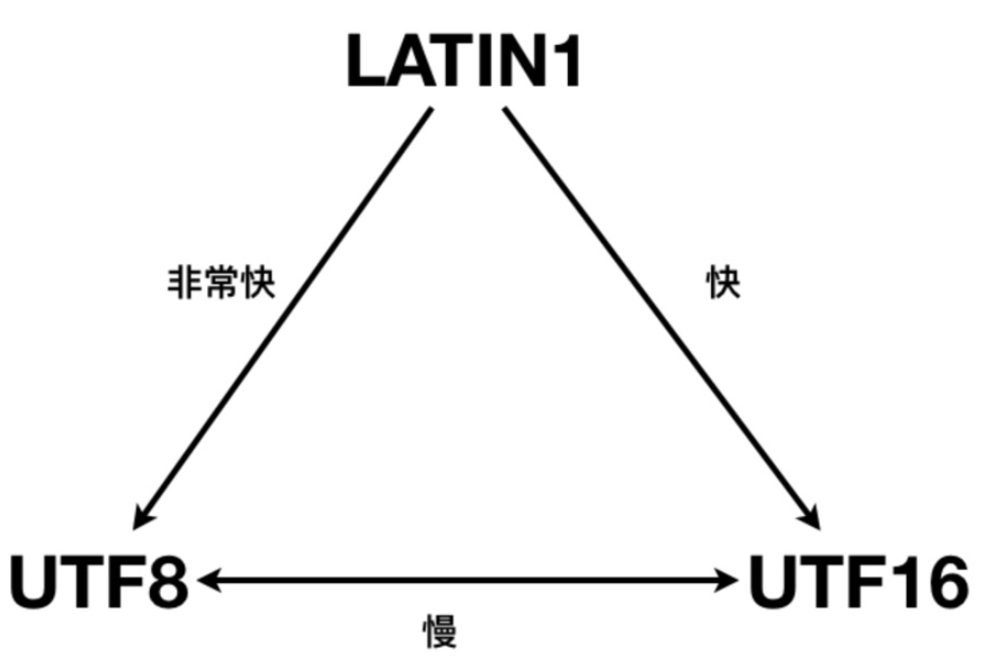Java字串編碼解碼效能怎麼提升
- WBOYWBOYWBOYWBOYWBOYWBOYWBOYWBOYWBOYWBOYWBOYWBOYWB轉載
- 2023-05-20 11:28:571291瀏覽
1.常見字串編碼
常見的字串編碼有:
LATIN1 只能儲存ASCII字符,又稱ISO -8859-1。
UTF-8是一種變長位元組編碼,使用1個、2個或3個位元組表示一個字元。由於中文通常需要3個位元組表示,中文場景UTF-8編碼通常需要更多的空間,替代的方案是GBK/GB2312/GB18030。
UTF-16 2個位元組,一個字元需要使用2個byte表示,又稱為UCS-2 (2-byte Universal Character Set)。根據大小端的區分,UTF-16有兩種形式,UTF-16BE和UTF-16LE,缺省UTF-16指UTF-16BE。 Java語言中的char是UTF-16LE編碼。
GB18030採用變長位元組編碼方式,每個字元使用1個、2個或3個位元組來表示。與UTF8類似,以2個字元表示中文可以節省位元組數,但這種方法在國際上不具通用性。

為了計算方便,記憶體中字串通常使用等寬字符,Java語言中char和.NET中的char都是使用UTF-16。早期Windows-NT只支援UTF-16。
2.編碼轉換效能
UTF-16和UTF-8之間轉換比較複雜,通常效能較差。

如下是一個將UTF-16轉換為UTF-8編碼的實現,可以看出演算法比較複雜,所以效能較差,這個操作也無法使用vector API做優化。
static int encodeUTF8(char[] utf16, int off, int len, byte[] dest, int dp) {
int sl = off + len, last_offset = sl - 1;
while (off < sl) {
char c = utf16[off++];
if (c < 0x80) {
// Have at most seven bits
dest[dp++] = (byte) c;
} else if (c < 0x800) {
// 2 dest, 11 bits
dest[dp++] = (byte) (0xc0 | (c >> 6));
dest[dp++] = (byte) (0x80 | (c & 0x3f));
} else if (c >= '\uD800' && c < '\uE000') {
int uc;
if (c < '\uDC00') {
if (off > last_offset) {
dest[dp++] = (byte) '?';
return dp;
}
char d = utf16[off];
if (d >= '\uDC00' && d < '\uE000') {
uc = (c << 10) + d + 0xfca02400;
} else {
throw new RuntimeException("encodeUTF8 error", new MalformedInputException(1));
}
} else {
uc = c;
}
dest[dp++] = (byte) (0xf0 | ((uc >> 18)));
dest[dp++] = (byte) (0x80 | ((uc >> 12) & 0x3f));
dest[dp++] = (byte) (0x80 | ((uc >> 6) & 0x3f));
dest[dp++] = (byte) (0x80 | (uc & 0x3f));
off++; // 2 utf16
} else {
// 3 dest, 16 bits
dest[dp++] = (byte) (0xe0 | ((c >> 12)));
dest[dp++] = (byte) (0x80 | ((c >> 6) & 0x3f));
dest[dp++] = (byte) (0x80 | (c & 0x3f));
}
}
return dp;
}由於Java中char是UTF-16LE編碼,如果需要將char[]轉換為UTF-16LE編碼的byte[]時,可以使用sun.misc.Unsafe#copyMemory方法快速拷貝。例如:
static int writeUtf16LE(char[] chars, int off, int len, byte[] dest, final int dp) {
UNSAFE.copyMemory(chars
, CHAR_ARRAY_BASE_OFFSET + off * 2
, dest
, BYTE_ARRAY_BASE_OFFSET + dp
, len * 2
);
dp += len * 2;
return dp;
}3.Java String的編碼
由於不同版本的JDK實作的字串處理方法不同,因此會出現不同的效能表現。在JDK 9之後,儘管char仍使用UTF-16編碼,但String內部也可以使用LATIN1編碼。
3.1. JDK 6之前的String實作
static class String {
final char[] value;
final int offset;
final int count;
}在Java 6之前,String.subString方法產生的String物件和原來String物件共用一個char[] value,這會導致subString方法傳回的String的char[]被引用而無法被GC回收。很多函式庫會避免使用subString方法,以防止在JDK 6及以下版本中出現問題。
3.2. JDK 7/8的String實作
static class String {
final char[] value;
}JDK 7之後,字串去掉了offset和count字段,value.length就是原來的count。這避免了subString引用大char[]的問題,優化也更容易,從而JDK7/8中的String操作效能比Java 6有較大提升。
3.3. JDK 9/10/11的實作
static class String {
final byte code;
final byte[] value;
static final byte LATIN1 = 0;
static final byte UTF16 = 1;
}JDK 9之後,value型別從char[]變成byte[],增加了一個欄位code,如果字元全部是ASCII字符,使用value使用LATIN編碼;如果存在任何一個非ASCII字符,則用UTF16編碼。這種混合編碼的方式,使得英文場景佔更少的記憶體。缺點是導致Java 9的String API效能可能不如JDK 8,特別是傳入char[]建構字串,會被做壓縮為latin編碼的byte[],有些場景會下降10%。
4.快速建構字串的方法
為了實現字串是不可變特性,建構字串的時候,會有拷貝的過程,如果要提升建構字串的開銷,就要避免這樣的拷貝。
例如如下是JDK8的String的一個建構子的實作
public final class String {
public String(char value[]) {
this.value = Arrays.copyOf(value, value.length);
}
}在JDK8中,有一個建構子是不做拷貝的,但這個方法不是public,需要用一個技巧實現MethodHandles.Lookup & LambdaMetafactory綁定反射來調用,文章後面有介紹這個技巧的程式碼。
public final class String {
String(char[] value, boolean share) {
// assert share : "unshared not supported";
this.value = value;
}
}快速建構字元的方法有三種:
使用MethodHandles.Lookup和LambdaMetafactory來綁定反射
#使用JavaLangAccess的相關方法
使用Unsafe直接建構
#1和2的效能相近,3稍微慢一些,但與直接使用new字符串相比,它們都更快。 JDK8使用JMH測試的資料如下:
在JDK 9之後,對全部是ASCII字元的場景,直接構造能達到更好的效果。Benchmark Mode Cnt 5 784869.350 ± 1936.754 ops/ms
StringCreateBenchmark.langAccess thrpt 5 784029.186 ± ops/ms
StringCreateBenchmark.unsafe thrpt 5 761176.319 ± 11914.549 ops/ms
StringCreateBenchmark.newString ops/ms
4.1 基于MethodHandles.Lookup & LambdaMetafactory绑定反射的快速构造字符串的方法
4.1.1 JDK8快速构造字符串
public static BiFunction<char[], Boolean, String> getStringCreatorJDK8() throws Throwable {
Constructor<MethodHandles.Lookup> constructor = MethodHandles.Lookup.class.getDeclaredConstructor(Class.class, int.class);
constructor.setAccessible(true);
MethodHandles lookup = constructor.newInstance(
String.class
, -1 // Lookup.TRUSTED
);
MethodHandles.Lookup caller = lookup.in(String.class);
MethodHandle handle = caller.findConstructor(
String.class, MethodType.methodType(void.class, char[].class, boolean.class)
);
CallSite callSite = LambdaMetafactory.metafactory(
caller
, "apply"
, MethodType.methodType(BiFunction.class)
, handle.type().generic()
, handle
, handle.type()
);
return (BiFunction) callSite.getTarget().invokeExact();
}4.1.2 JDK 11快速构造字符串的方法
public static ToIntFunction<String> getStringCode11() throws Throwable {
Constructor<MethodHandles.Lookup> constructor = MethodHandles.Lookup.class.getDeclaredConstructor(Class.class, int.class);
constructor.setAccessible(true);
MethodHandles.Lookup lookup = constructor.newInstance(
String.class
, -1 // Lookup.TRUSTED
);
MethodHandles.Lookup caller = lookup.in(String.class);
MethodHandle handle = caller.findVirtual(
String.class, "coder", MethodType.methodType(byte.class)
);
CallSite callSite = LambdaMetafactory.metafactory(
caller
, "applyAsInt"
, MethodType.methodType(ToIntFunction.class)
, MethodType.methodType(int.class, Object.class)
, handle
, handle.type()
);
return (ToIntFunction<String>) callSite.getTarget().invokeExact();
}if (JDKUtils.JVM_VERSION == 11) {
Function<byte[], String> stringCreator = JDKUtils.getStringCreatorJDK11();
byte[] bytes = new byte[]{'a', 'b', 'c'};
String apply = stringCreator.apply(bytes);
assertEquals("abc", apply);
}4.1.3 JDK 17快速构造字符串的方法
在JDK 17中,MethodHandles.Lookup使用Reflection.registerFieldsToFilter对lookupClass和allowedModes做了保护,网上搜索到的通过修改allowedModes的办法是不可用的。
在JDK 17中,要通过配置JVM启动参数才能使用MethodHandlers。如下:
--add-opens java.base/java.lang.invoke=ALL-UNNAMED
public static BiFunction<byte[], Charset, String> getStringCreatorJDK17() throws Throwable {
Constructor<MethodHandles.Lookup> constructor = MethodHandles.Lookup.class.getDeclaredConstructor(Class.class, Class.class, int.class);
constructor.setAccessible(true);
MethodHandles.Lookup lookup = constructor.newInstance(
String.class
, null
, -1 // Lookup.TRUSTED
);
MethodHandles.Lookup caller = lookup.in(String.class);
MethodHandle handle = caller.findStatic(
String.class, "newStringNoRepl1", MethodType.methodType(String.class, byte[].class, Charset.class)
);
CallSite callSite = LambdaMetafactory.metafactory(
caller
, "apply"
, MethodType.methodType(BiFunction.class)
, handle.type().generic()
, handle
, handle.type()
);
return (BiFunction<byte[], Charset, String>) callSite.getTarget().invokeExact();
}if (JDKUtils.JVM_VERSION == 17) {
BiFunction<byte[], Charset, String> stringCreator = JDKUtils.getStringCreatorJDK17();
byte[] bytes = new byte[]{'a', 'b', 'c'};
String apply = stringCreator.apply(bytes, StandardCharsets.US_ASCII);
assertEquals("abc", apply);
}4.2 基于JavaLangAccess快速构造
通过SharedSecrets提供的JavaLangAccess,也可以不拷贝构造字符串,但是这个比较麻烦,JDK 8/11/17的API都不一样,对一套代码兼容不同的JDK版本不方便,不建议使用。
JavaLangAccess javaLangAccess = SharedSecrets.getJavaLangAccess(); javaLangAccess.newStringNoRepl(b, StandardCharsets.US_ASCII);
4.3 基于Unsafe实现快速构造字符串
public static final Unsafe UNSAFE;
static {
Unsafe unsafe = null;
try {
Field theUnsafeField = Unsafe.class.getDeclaredField("theUnsafe");
theUnsafeField.setAccessible(true);
unsafe = (Unsafe) theUnsafeField.get(null);
} catch (Throwable ignored) {}
UNSAFE = unsafe;
}
////////////////////////////////////////////
Object str = UNSAFE.allocateInstance(String.class);
UNSAFE.putObject(str, valueOffset, chars);注意:在JDK 9之后,实现是不同,比如:
Object str = UNSAFE.allocateInstance(String.class); UNSAFE.putByte(str, coderOffset, (byte) 0); UNSAFE.putObject(str, valueOffset, (byte[]) bytes);
4.4 快速构建字符串的技巧应用:
如下的方法格式化日期为字符串,性能就会非常好。
public String formatYYYYMMDD(Calendar calendar) throws Throwable {
int year = calendar.get(Calendar.YEAR);
int month = calendar.get(Calendar.MONTH) + 1;
int dayOfMonth = calendar.get(Calendar.DAY_OF_MONTH);
byte y0 = (byte) (year / 1000 + '0');
byte y1 = (byte) ((year / 100) % 10 + '0');
byte y2 = (byte) ((year / 10) % 10 + '0');
byte y3 = (byte) (year % 10 + '0');
byte m0 = (byte) (month / 10 + '0');
byte m1 = (byte) (month % 10 + '0');
byte d0 = (byte) (dayOfMonth / 10 + '0');
byte d1 = (byte) (dayOfMonth % 10 + '0');
if (JDKUtils.JVM_VERSION >= 9) {
byte[] bytes = new byte[] {y0, y1, y2, y3, m0, m1, d0, d1};
if (JDKUtils.JVM_VERSION == 17) {
return JDKUtils.getStringCreatorJDK17().apply(bytes, StandardCharsets.US_ASCII);
}
if (JDKUtils.JVM_VERSION <= 11) {
return JDKUtils.getStringCreatorJDK11().apply(bytes);
}
return new String(bytes, StandardCharsets.US_ASCII);
}
char[] chars = new char[]{
(char) y0,
(char) y1,
(char) y2,
(char) y3,
(char) m0,
(char) m1,
(char) d0,
(char) d1
};
if (JDKUtils.JVM_VERSION == 8) {
return JDKUtils.getStringCreatorJDK8().apply(chars, true);
}
return new String(chars);
}5.快速遍历字符串的办法
无论JDK什么版本,String.charAt都是一个较大的开销,JIT的优化效果并不好,无法消除参数index范围检测的开销,不如直接操作String里面的value数组。
public final class String {
private final char value[];
public char charAt(int index) {
if ((index < 0) || (index >= value.length)) {
throw new StringIndexOutOfBoundsException(index);
}
return value[index];
}
}在JDK 9之后的版本,charAt开销更大
public final class String {
private final byte[] value;
private final byte coder;
public char charAt(int index) {
if (isLatin1()) {
return StringLatin1.charAt(value, index);
} else {
return StringUTF16.charAt(value, index);
}
}
}5.1 获取String.value的方法
获取String.value的方法有如下:
使用Field反射
使用Unsafe
Unsafe和Field反射在JDK 8 JMH的比较数据如下:
Benchmark Mode Cnt Score Error Units
StringGetValueBenchmark.reflect thrpt 5 438374.685 ± 1032.028 ops/ms
StringGetValueBenchmark.unsafe thrpt 5 1302654.150 ± 59169.706 ops/ms
5.1.1 使用反射获取String.value
static Field valueField;
static {
try {
valueField = String.class.getDeclaredField("value");
valueField.setAccessible(true);
} catch (NoSuchFieldException ignored) {}
}
////////////////////////////////////////////
char[] chars = (char[]) valueField.get(str);5.1.2 使用Unsafe获取String.value
static long valueFieldOffset;
static {
try {
Field valueField = String.class.getDeclaredField("value");
valueFieldOffset = UNSAFE.objectFieldOffset(valueField);
} catch (NoSuchFieldException ignored) {}
}
////////////////////////////////////////////
char[] chars = (char[]) UNSAFE.getObject(str, valueFieldOffset);static long valueFieldOffset;
static long coderFieldOffset;
static {
try {
Field valueField = String.class.getDeclaredField("value");
valueFieldOffset = UNSAFE.objectFieldOffset(valueField);
Field coderField = String.class.getDeclaredField("coder");
coderFieldOffset = UNSAFE.objectFieldOffset(coderField);
} catch (NoSuchFieldException ignored) {}
}
////////////////////////////////////////////
byte coder = UNSAFE.getObject(str, coderFieldOffset);
byte[] bytes = (byte[]) UNSAFE.getObject(str, valueFieldOffset);6.更快的encodeUTF8方法
当能直接获取到String.value时,就可以直接对其做encodeUTF8操作,会比String.getBytes(StandardCharsets.UTF_8)性能好很多。
6.1 JDK8高性能encodeUTF8的方法
public static int encodeUTF8(char[] src, int offset, int len, byte[] dst, int dp) {
int sl = offset + len;
int dlASCII = dp + Math.min(len, dst.length);
// ASCII only optimized loop
while (dp < dlASCII && src[offset] < '\u0080') {
dst[dp++] = (byte) src[offset++];
}
while (offset < sl) {
char c = src[offset++];
if (c < 0x80) {
// Have at most seven bits
dst[dp++] = (byte) c;
} else if (c < 0x800) {
// 2 bytes, 11 bits
dst[dp++] = (byte) (0xc0 | (c >> 6));
dst[dp++] = (byte) (0x80 | (c & 0x3f));
} else if (c >= '\uD800' && c < ('\uDFFF' + 1)) { //Character.isSurrogate(c) but 1.7
final int uc;
int ip = offset - 1;
if (c >= '\uD800' && c < ('\uDBFF' + 1)) { // Character.isHighSurrogate(c)
if (sl - ip < 2) {
uc = -1;
} else {
char d = src[ip + 1];
// d >= '\uDC00' && d < ('\uDFFF' + 1)
if (d >= '\uDC00' && d < ('\uDFFF' + 1)) { // Character.isLowSurrogate(d)
uc = ((c << 10) + d) + (0x010000 - ('\uD800' << 10) - '\uDC00'); // Character.toCodePoint(c, d)
} else {
dst[dp++] = (byte) '?';
continue;
}
}
} else {
//
if (c >= '\uDC00' && c < ('\uDFFF' + 1)) { // Character.isLowSurrogate(c)
dst[dp++] = (byte) '?';
continue;
} else {
uc = c;
}
}
if (uc < 0) {
dst[dp++] = (byte) '?';
} else {
dst[dp++] = (byte) (0xf0 | ((uc >> 18)));
dst[dp++] = (byte) (0x80 | ((uc >> 12) & 0x3f));
dst[dp++] = (byte) (0x80 | ((uc >> 6) & 0x3f));
dst[dp++] = (byte) (0x80 | (uc & 0x3f));
offset++; // 2 chars
}
} else {
// 3 bytes, 16 bits
dst[dp++] = (byte) (0xe0 | ((c >> 12)));
dst[dp++] = (byte) (0x80 | ((c >> 6) & 0x3f));
dst[dp++] = (byte) (0x80 | (c & 0x3f));
}
}
return dp;
}使用encodeUTF8方法举例
char[] chars = UNSAFE.getObject(str, valueFieldOffset); // ensureCapacity(chars.length * 3) byte[] bytes = ...; // int bytesLength = IOUtils.encodeUTF8(chars, 0, chars.length, bytes, bytesOffset);
这样encodeUTF8操作,不会有多余的arrayCopy操作,性能会得到提升。
6.1.1 性能测试比较
测试代码
public class EncodeUTF8Benchmark {
static String STR = "01234567890ABCDEFGHIJKLMNOPQRSTUVWZYZabcdefghijklmnopqrstuvwzyz一二三四五六七八九十";
static byte[] out;
static long valueFieldOffset;
static {
out = new byte[STR.length() * 3];
try {
Field valueField = String.class.getDeclaredField("value");
valueFieldOffset = UnsafeUtils.UNSAFE.objectFieldOffset(valueField);
} catch (NoSuchFieldException e) {
e.printStackTrace();
}
}
@Benchmark
public void unsafeEncodeUTF8() throws Exception {
char[] chars = (char[]) UnsafeUtils.UNSAFE.getObject(STR, valueFieldOffset);
int len = IOUtils.encodeUTF8(chars, 0, chars.length, out, 0);
}
@Benchmark
public void getBytesUTF8() throws Exception {
byte[] bytes = STR.getBytes(StandardCharsets.UTF_8);
System.arraycopy(bytes, 0, out, 0, bytes.length);
}
public static void main(String[] args) throws RunnerException {
Options options = new OptionsBuilder()
.include(EncodeUTF8Benchmark.class.getName())
.mode(Mode.Throughput)
.timeUnit(TimeUnit.MILLISECONDS)
.forks(1)
.build();
new Runner(options).run();
}
}测试结果
EncodeUTF8Benchmark.getBytesUTF8 thrpt 5 20690.960 ± 5431.442 ops/ms
EncodeUTF8Benchmark.unsafeEncodeUTF8 thrpt 5 34508.606 ± 55.510 ops/ms
从结果来看,通过unsafe + 直接调用encodeUTF8方法, 编码的所需要开销是newStringUTF8的58%。
6.2 JDK9/11/17高性能encodeUTF8的方法
public static int encodeUTF8(byte[] src, int offset, int len, byte[] dst, int dp) {
int sl = offset + len;
while (offset < sl) {
byte b0 = src[offset++];
byte b1 = src[offset++];
if (b1 == 0 && b0 >= 0) {
dst[dp++] = b0;
} else {
char c = (char)(((b0 & 0xff) << 0) | ((b1 & 0xff) << 8));
if (c < 0x800) {
// 2 bytes, 11 bits
dst[dp++] = (byte) (0xc0 | (c >> 6));
dst[dp++] = (byte) (0x80 | (c & 0x3f));
} else if (c >= '\uD800' && c < ('\uDFFF' + 1)) { //Character.isSurrogate(c) but 1.7
final int uc;
int ip = offset - 1;
if (c >= '\uD800' && c < ('\uDBFF' + 1)) { // Character.isHighSurrogate(c)
if (sl - ip < 2) {
uc = -1;
} else {
b0 = src[ip + 1];
b1 = src[ip + 2];
char d = (char) (((b0 & 0xff) << 0) | ((b1 & 0xff) << 8));
// d >= '\uDC00' && d < ('\uDFFF' + 1)
if (d >= '\uDC00' && d < ('\uDFFF' + 1)) { // Character.isLowSurrogate(d)
uc = ((c << 10) + d) + (0x010000 - ('\uD800' << 10) - '\uDC00'); // Character.toCodePoint(c, d)
} else {
return -1;
}
}
} else {
//
if (c >= '\uDC00' && c < ('\uDFFF' + 1)) { // Character.isLowSurrogate(c)
return -1;
} else {
uc = c;
}
}
if (uc < 0) {
dst[dp++] = (byte) '?';
} else {
dst[dp++] = (byte) (0xf0 | ((uc >> 18)));
dst[dp++] = (byte) (0x80 | ((uc >> 12) & 0x3f));
dst[dp++] = (byte) (0x80 | ((uc >> 6) & 0x3f));
dst[dp++] = (byte) (0x80 | (uc & 0x3f));
offset++; // 2 chars
}
} else {
// 3 bytes, 16 bits
dst[dp++] = (byte) (0xe0 | ((c >> 12)));
dst[dp++] = (byte) (0x80 | ((c >> 6) & 0x3f));
dst[dp++] = (byte) (0x80 | (c & 0x3f));
}
}
}
return dp;
}使用encodeUTF8方法举例
byte coder = UNSAFE.getObject(str, coderFieldOffset);
byte[] value = UNSAFE.getObject(str, coderFieldOffset);
if (coder == 0) {
// ascii arraycopy
} else {
// ensureCapacity(chars.length * 3)
byte[] bytes = ...; //
int bytesLength = IOUtils.encodeUTF8(value, 0, value.length, bytes, bytesOffset);
}这样encodeUTF8操作,不会有多余的arrayCopy操作,性能会得到提升。
以上是Java字串編碼解碼效能怎麼提升的詳細內容。更多資訊請關注PHP中文網其他相關文章!

